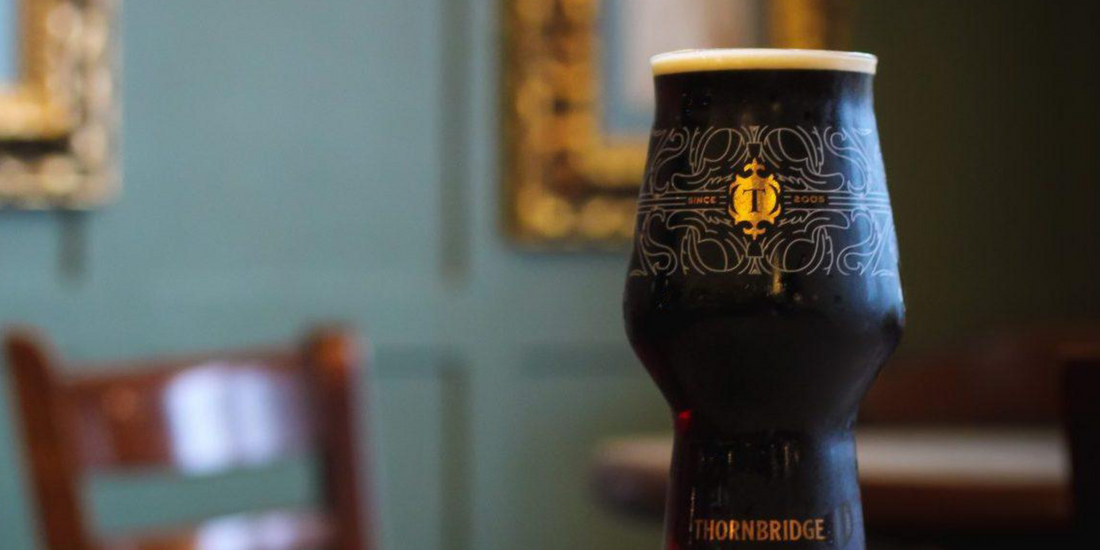
Hello Darkness, my old friend.
Share
Beer varies in colour from straw yellow through to deep, dark black. They say that all beer is a shade of red, the sky isn’t actually blue and the sun isn’t yellow. Whilst that’s all true, what matters most is the drinker’s reaction to the colour of the beer presented to them and how it tastes and makes them feel.
Although probably less than 10% of UK beer sales are made up of dark beers, as soon as the clocks go back in Autumn, we naturally start leaning towards the darker beers on the bar. The fires are lit and it’s dark outside, so we go for a pint of something rich and a little more indulgent. There’s still plenty of pale lager sloshing down throats nationwide, but there’s just something a little bit different about a nice pint of porter or stout.
Porter dates back to the 1700s when there was a lot of brown beer being made in London and Stout would mean a strong beer. Over the years, stout has become synonymous with black beer but the change in colour really happened in the early 1800s. A man named Daniel Wheeler produced a drum roaster which could produce a very dark roasted malt that was much better for colouring beer than the brown malts of the time. This black ‘patent’ malt is still a staple of dark beer production today.
Barley, being the main source of carbohydrate for beer production, requires malting before use in the brewery. The maltster will steep the grain in water to begin germination before halting the process with dryers and then kiln or roast the malt to add colour and flavour. The longer and hotter the process occurs, the darker the grain becomes. It only takes a small amount of dark malt to turn a beer jet black. The three main dark malts are Chocolate malt, Black malt and one which isn’t actually malted before it is kilned. Roasted barley is just that - barley that has been roasted until it gives a burnt coffee, acrid and even slightly acidic flavour to dry stouts and Baltic porters. Chocolate malt is much more rounded with flavours of cocoa and a smoother flavour compared to black or roasted barley.
At Thornbridge, we make several dark beers that we feel fit into the feeling and taste people want from a dark beer. Our 4.5% porter, Market Porter uses Pale, Munich, Brown, Crystal, Wheat and Black malts to give a dark colour with a creamy head and slightly roasted aftertaste. Smoother than a stout and less aggressive flavour-wise, it’s a great beer to have in the fridge if you just fancy something soothing or even down the pub if you want that pint of comfort. Another reason dark beer is so popular in winter and early spring is that rich, wholesome foods like stews or roasted meats pair so well with a beer that can stand up and complement the dish. Likewise, sweet desserts like chocolate brownies bring out the cocoa flavours dark malt brings to beer.
Although probably less than 10% of UK beer sales are made up of dark beers, as soon as the clocks go back in Autumn, we naturally start leaning towards the darker beers on the bar. The fires are lit and it’s dark outside, so we go for a pint of something rich and a little more indulgent. There’s still plenty of pale lager sloshing down throats nationwide, but there’s just something a little bit different about a nice pint of porter or stout.
Porter dates back to the 1700s when there was a lot of brown beer being made in London and Stout would mean a strong beer. Over the years, stout has become synonymous with black beer but the change in colour really happened in the early 1800s. A man named Daniel Wheeler produced a drum roaster which could produce a very dark roasted malt that was much better for colouring beer than the brown malts of the time. This black ‘patent’ malt is still a staple of dark beer production today.
Barley, being the main source of carbohydrate for beer production, requires malting before use in the brewery. The maltster will steep the grain in water to begin germination before halting the process with dryers and then kiln or roast the malt to add colour and flavour. The longer and hotter the process occurs, the darker the grain becomes. It only takes a small amount of dark malt to turn a beer jet black. The three main dark malts are Chocolate malt, Black malt and one which isn’t actually malted before it is kilned. Roasted barley is just that - barley that has been roasted until it gives a burnt coffee, acrid and even slightly acidic flavour to dry stouts and Baltic porters. Chocolate malt is much more rounded with flavours of cocoa and a smoother flavour compared to black or roasted barley.
At Thornbridge, we make several dark beers that we feel fit into the feeling and taste people want from a dark beer. Our 4.5% porter, Market Porter uses Pale, Munich, Brown, Crystal, Wheat and Black malts to give a dark colour with a creamy head and slightly roasted aftertaste. Smoother than a stout and less aggressive flavour-wise, it’s a great beer to have in the fridge if you just fancy something soothing or even down the pub if you want that pint of comfort. Another reason dark beer is so popular in winter and early spring is that rich, wholesome foods like stews or roasted meats pair so well with a beer that can stand up and complement the dish. Likewise, sweet desserts like chocolate brownies bring out the cocoa flavours dark malt brings to beer.

We launched a few special dark beers in January and they both take a great base and add a little something extra to make them stand apart and feel like a bit of a treat. McConnel’s is our vanilla stout and, at 5%, is a bit stronger than Market Porter and certainly a lot smoother, with vanilla being the star of the show. If that’s not enough of a dessert and you like your dark beers even sweeter, then Coco Cocoa might be the one for you! Our coconut chocolate porter is like my favourite chocolate bar, a Bounty. I’ve never met anyone that agreed with me on that, but it’s of little concern to me, as it means there is always plenty left at the bottom of the box. Coconut aroma and flavour with added lactose for sweetness work perfectly with a rich, chocolatey porter. At 5.5%, it is the baby sibling to our stronger chocolate porter Cocoa Wonderland.
If sweetness isn’t your thing, then we’ve also recently launched a nitro stout, Brock. A dry, crisp, moreish stout that uses nitrogen gas for a thick creamy head. You’ll recognise it by the famous falling bubbles that appear on the side of the glass and the slow, gradual settling of the beer. Some might say it was worth waiting for it to settle.

There’s one other dark beer that really has to be tried at least once, although it’s difficult to not have a few in the back of the cupboard for Sunday evenings. Necessary Evil is an imperial stout, which means it’s strong; 13% for the aged versions which have undergone months in barrel. The main variant is from bourbon casks and in 375ml bottles is great to open after a meal alongside dessert or as the dessert itself. Rich, warming and smooth, it has vanilla and oak from the cask as well as bourbon aromas and flavours that can only come from being in wood for a period of time.

Dark beer is something different, something to savour and something to enjoy. At this time of year, with the wind howling and the rain beating down, there are few things that feel like they can wrap you up and keep the storm outside at bay. Good hot food and good dark beer are two such things. Get it while it lasts and support your local breweries and pubs in the coming months. It’ll soon be summer and time for fizzy lager, but until then, a smooth pint of Porter is what’s needed.
Written by Ben Wood, Technical Brewer.

3 comments
Great blog love all your dark beers regardless of the weather, especially the necessary evil an unbelievable ale.Keep up the great work.Looking forward to visiting your tap room in the summer.
No need to compete with Brewdog over Guinness, just be different in strength (say 5%, albeit duty noted) or flavour, or whatever just keep the different identlity.
Interesting how stout and dark beers are having a bit of a resurgence presently, although despite this interest many publicans still seem to be stuck on offering lighter beers, which to my mind are less seasonally appropriate. Hopefully they will gradually catch up… Nice to see the McConnels is being brewed again, that was a superb beer a few years ago, hopefully the recipe hasn’t changed. It’d also be good to see the St Petersburg become available again.